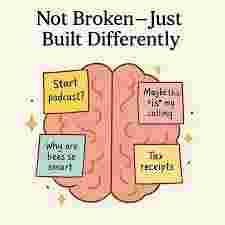For many people with Attention Deficit Hyperactivity Disorder, life becomes a performance. They learn how to act “normal,” to fit into environments that don’t understand their struggles. This act is often described as masking—hiding ADHD traits behind practiced behaviors so others won’t see the difficulties within. While it helps avoid judgment, masking takes a heavy emotional toll. The world may see competence, but inside there is exhaustion, self-doubt, and the constant fear of being discovered.
Why People Mask ADHD
Masking often begins in childhood. A student who blurts out answers, forgets homework, or can’t sit still quickly learns that these behaviors are labeled as disruptive. To avoid punishment or shame, they suppress natural impulses, forcing themselves into patterns that don’t match how their brain works.
In adulthood, the reasons for masking shift but remain powerful. At work, masking might mean staying late to finish tasks others complete easily, over-preparing to avoid mistakes, or forcing eye contact during conversations to appear engaged. In relationships, it might mean hiding forgetfulness, covering up impulsive remarks, or avoiding situations that could reveal struggles.
The drive to mask often stems from stigma. The symptoms of ADHD are frequently misunderstood, interpreted as laziness, immaturity, or lack of discipline. By hiding, people hope to protect their reputation and relationships, even if it comes at their own expense.
The Emotional Cost of Hiding
Masking may create an illusion of control, but it leaves individuals drained. Pretending to be someone else requires constant effort and hyper-awareness, leading to stress and burnout. Many people describe a disconnect between the version of themselves they show the world and their private reality.
Over time, this gap can affect self-esteem. If every success feels like it was earned through pretending, authenticity gets lost. The person beneath the mask begins to wonder if they are truly capable or if they are only “good enough” when hiding their ADHD. This internal struggle often leads to anxiety, depression, and feelings of isolation.
Symptoms That Are Hard to Hide
Even the most practiced masks can slip. Forgetfulness, procrastination, hyperfocus, and restlessness are among the symptoms of ADHD that tend to surface despite efforts to conceal them. When this happens, individuals may feel exposed or fear that others will finally see the challenges they’ve been working so hard to cover up.
These moments of exposure often reinforce the cycle of masking. Rather than risk judgment, people double down on concealing their struggles, leading to even greater exhaustion.
The Role of Treatment in Removing the Mask
Breaking free from the exhausting cycle of masking often begins with seeking the right help. The treatment of ADHD provides tools to manage symptoms more effectively, reducing the need to hide them. Therapy, coaching, and support groups help individuals build strategies tailored to their unique brains. These approaches encourage authenticity by teaching healthier ways to navigate challenges rather than cover them up.
Perhaps most importantly, treatment emphasizes self-compassion. Instead of blaming themselves for not fitting into rigid systems, people learn to honor their differences and create environments that work with their brains instead of against them.
Medication as a Bridge to Authenticity
The medication of ADHD can also play an important role in easing the burden of masking. By improving focus, reducing impulsivity, and supporting organization, medication helps minimize the chaos that often drives individuals to hide. When daily tasks become more manageable, there is less pressure to pretend, and more room to live authentically.
However, medication alone is not the solution. It works best when paired with therapy and self-awareness. Together, these supports help individuals strike a balance—managing symptoms while also embracing who they are, mask-free.
Unmasking in Safe Spaces
Removing the mask is not easy. It requires trust and supportive environments where individuals feel safe to show their struggles without fear of judgment. This often starts with close relationships—friends, family, or partners who accept ADHD as part of a person’s identity rather than a flaw.
Workplaces and schools also play a crucial role. When these environments foster understanding and provide accommodations, people with ADHD can thrive without needing to hide. Unmasking in safe spaces is a step toward living fully and authentically, free from the constant weight of pretense.
Reclaiming Identity Beyond the Mask
Unmasking isn’t just about dropping behaviors—it’s about reclaiming identity. People with ADHD are often incredibly creative, resilient, and resourceful. Their unique perspectives allow them to approach problems differently, often in ways others might never consider. By stepping out from behind the mask, individuals can embrace both the challenges and strengths that ADHD brings.
The journey to unmasking is also about rewriting the narrative. ADHD does not equal failure. It is not laziness or lack of intelligence. Instead, it is a different way of experiencing the world—one that comes with hurdles but also with hidden potential.
Closing Reflection
The mask worn by those with ADHD protects them from stigma but comes at a steep price: exhaustion, isolation, and a fractured sense of self. Through the treatment of ADHD, mindful use of medication of ADHD, and acceptance of the symptoms of ADHD, individuals can begin to lower the mask and step into authenticity.
Living openly with ADHD is not about exposing flaws but about embracing humanity. True strength lies not in perfection but in honesty—the courage to be seen as you are. When the mask comes off, what remains is not weakness but resilience, creativity, and the undeniable truth of self-acceptance.




